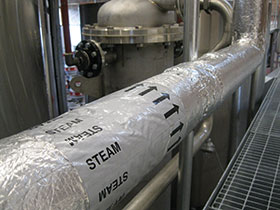

Founded in 2011, Embedded Energy Technology was the brainchild of a team of entrepreneurs who had previously worked for a company that developed a robotic inspection system. It incorporated sonar, laser and measurement sensors, for water treatment and sewer systems, an industry that had not really changed in a hundred years or more.
They decided to look around for a new challenge in an industry where they could apply the lessons learned; an older industry where there had not been any great technology advancement in decades, but where new technology could bring some huge benefits. One of the partners owned a company that made removable insulation for steam system components, and was seeing customer demand for post-installation verification of the energy savings provided by industrial insulation products. As a result, Embedded Energy Technology was formed.
Providing a complete energy saving dashboard
Many large buildings, campuses, hospitals etc. all have giant industrial steam systems, and the amount of energy that goes through them is massive. The steam systems are used not only for heating buildings in cold areas, but also for cooling them via heat exchangers in hot areas, or for sterilisation of equipment in places such as hospitals.
“Insulation is placed on steam pipes that are radiating energy, and over time it may be removed to replace a component, or get ripped off, either way the pipes then radiate heat into the environment. This can lead to a situation where excess energy is being used to convert water to steam, raising the ambient temperature of facilities, often to intolerable levels. In many cases it is like having the heat and the A/C on at the same time,” said Embedded Energy Technology CEO, P.J. Johns.
The sale of the removable insulation jackets that allow maintenance teams to be able to remove a jacket, work on the component, and then replace, is largely based on the energy savings numbers, and the company was frequently being asked to prove how much energy was being saved. Therefore, the engineers at EET developed a sensor that could be mounted along with the insulation to measure how much heat is being retained and provide insight into whether or not the component is functioning as intended.
Each sensor measures 4 key temperatures: the inside jacket temperature, the outer jacket (touch) temperature, the ambient room or steam vault temperature, and the component temperature.
These readings provide a complete picture of what is happening inside the component, and are displayed in a Web portal that analyses and presents the data in a concise format.
The dashboard interface also lets users set up email and text message alerts to be triggered when temperatures of the sensors selected fall outside a preset range. Summary reports are emailed monthly that highlight total energy savings, component health and month-over-month/year-over-year comparisons.
Staff and efficiency savings realised
“Initially we thought that we would need to hire a couple of developers and build something from scratch over the course of a year, but once we saw the ThingWorx platform, we realised that we could skip that step,” noted Johns. “The flexibility, and rapid application development tools, along with the look of the applications, made it a much more practical proposition than building something from scratch.”
In fact, the work that was planned to create the new platform was scoped to be done by three developers, but due to the ease of use of the platform, Embedded Energy Technology only needed one developer. “That cost saving helped to justify the purchase of ThingWorx,” said Johns. “We also see efficiencies with the backend work that we have to do such as updating gateway software, or commissioning new sensors. With ThingWorx, these can now be automated rather than engaging someone to run scripts on each system.”
In addition, customers will be able to self-serve in terms of updating mailing lists for e-mail or text alerts, or changing alert parameters, all of which was a manual process for EET in the past. This flexibility, was one of the key reasons EET chose ThingWorx as their IoT platform, “It is a well thought out system,” continued Johns, “every type of issue that we had run into, or that we could think of, had already been incorporated in the design of the product and built in from the bottom up which was impressive. On top of that, getting something developed whether it be a mashup, a custom visualisation, or prototype applications such as monitoring battery drain, are all fast to develop, and do not require a programming background to accomplish.”
Johns’ vision is that the portal becomes a one-stop shop for their customers. “We want them to log in, be able to check their sensors and have the portal become their default platform as we add more inputs and sensors to provide a wider range of information.”
For more information contact Duan Gauche, 1Worx, +27 (0)12 654 0056, [email protected], www.1worx.co

© Technews Publishing (Pty) Ltd | All Rights Reserved